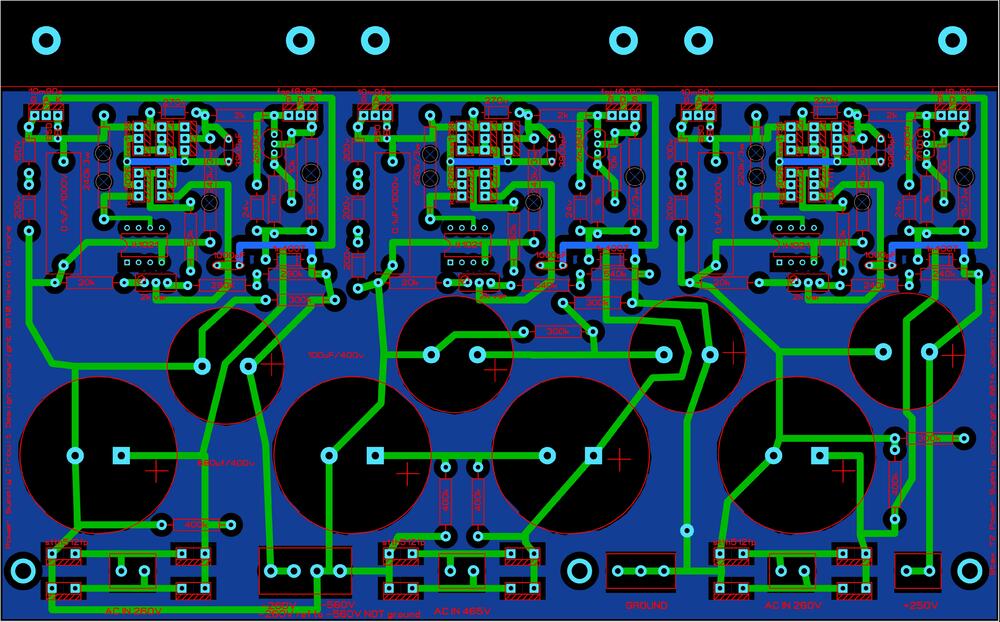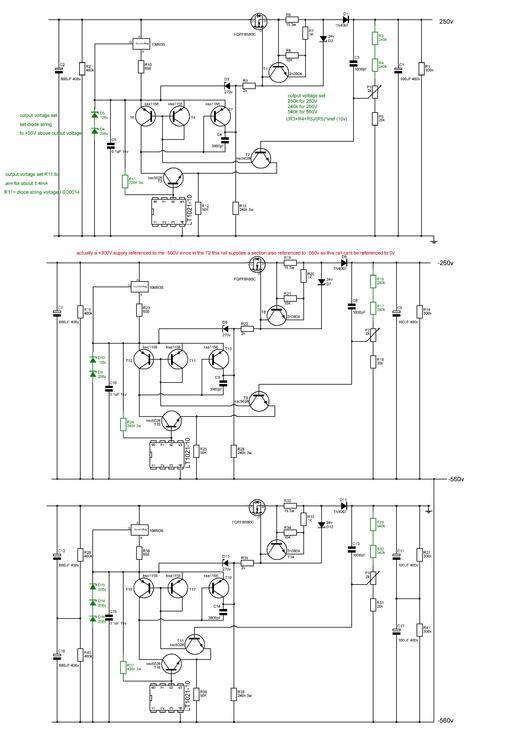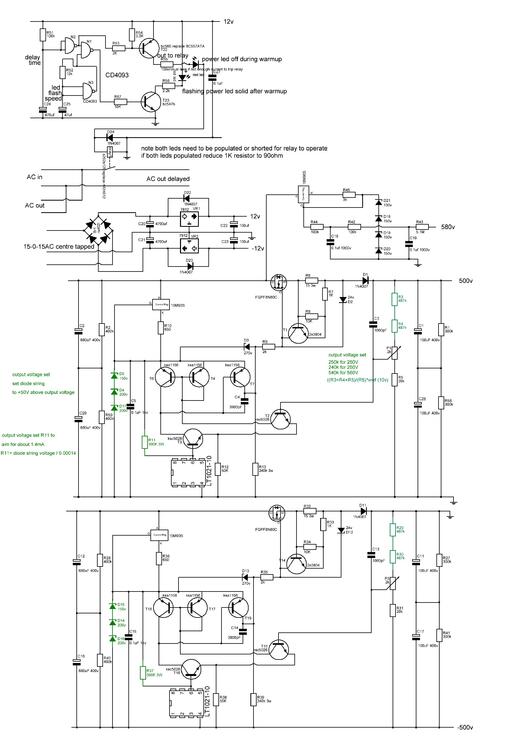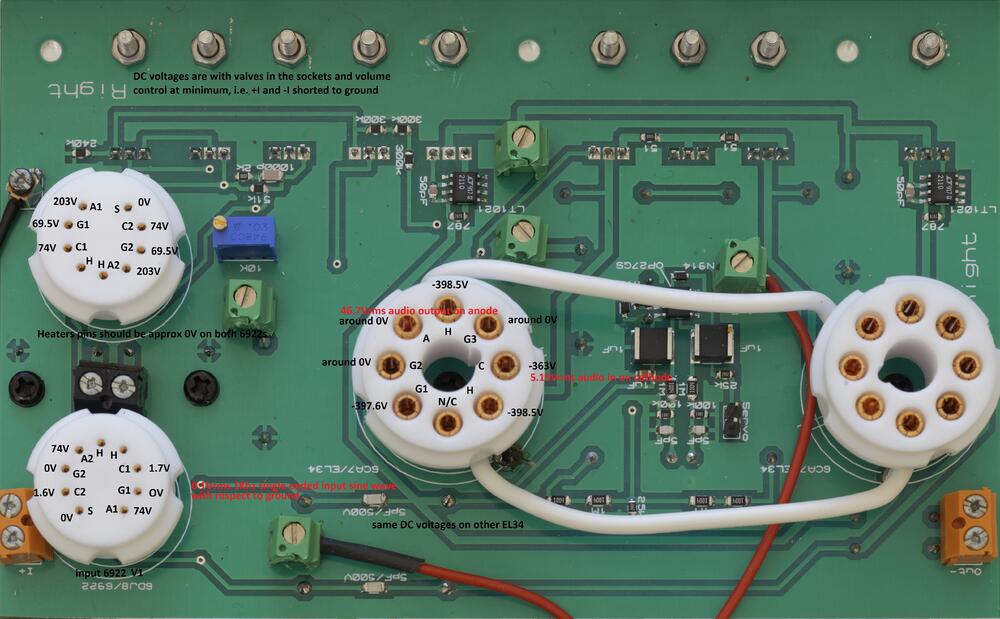
jamesmking
High Rollers-
Posts
406 -
Joined
-
Last visited
-
Days Won
1
Content Type
Profiles
Forums
Events
Everything posted by jamesmking
-
Here the latest T2 psus, I have modified the layout to provide more space around the rather hot R11 3W resistor and added vent holes to the pcb. The pcbs, transformers etc still fit inside a 400mm deep case without issue. I noticed that the R11 equivalent resistor on the + and - 500V rails runs considerably hotter than the equivalent resistor on the other rails (which also run quite hot).... doing some quick maths, R11 is approximately 1000ohms * the value of the zener serial train /1.818 on all the psus rails except for the +and -500V... Using this formula gives 300Kohms for the + and - 500V rails but in the original gerbers I worked from only have 240K there. This results in higher current flow through the resistor and more power dissipation and hence the higher temperature. EDIT: thank you Joamat for suggesting the current through R11 should be 1.1mA or more. The R11 values here on all rails are based around 1.4mA with values available in the PR03 Vishay range or 3W resistors. Resulting in lower power dissipation on all rails and especially the +-500V The gerbers with the vents have been used to make functioning psus and can be considered tested. This pcb is 220mm wide by 137mm deep and contains the -260V, -560V and +250V rails t2 kgsshv 250v -260v -560v corrected.zip ---------------------------------------------------------------------------------------------------------------- This pcb is 220mm wide by 148.5mm deep and contains the low voltage rails, delay and the +-500V rails with the adjusted 3W resistor t2 kgsshv +-500v, lv, bias and delay corrected.zip
-
goldenreference low voltage power supply
jamesmking replied to kevin gilmore's topic in Do It Yourself
The output voltage is set by two resistors R8/R7 and R10/R9 (see schematic below). the trim pots make only very small adjustments - a few mV for those who want spot on voltages - there is a trade-off between adjustment range and temperature stability. If you want more adjustment range decrease the value of R24,R23,R18,R17. 810K instead of 1M for each gives about + and - 20mV adjustment range. If you want reasonably accurate voltages AND lower temperature drift you can use 0.1% resistors for R8,R7,R10 and R9 with low temperature coefficients (stock resistors are usually about 100ppm, 0.1% are usually around 25ppm) and omit the 1M ohm resistors and trim pot. -
Simplified explanation: There are multiple methods for changing how a transistor or valve conducts. You can vary the voltage on valve grid or current on the transistor base. Another way is to vary the current supply to the transistor emitter, collector or valve anode or cathode, another way is to vary the voltage at the valve cathode. .. Just because the valve grid or transistor base does not have audio directly applied does not mean that there is no audio passing through the device.... Q1 is constant current. Since its emitter has a constant load and voltage applied and so has a constant current available and the base also has a fixed resistor and fixed voltage. Rv1 can adjust slightly the overall emitter resistance and therefore available current to each half of Q1 so some current balancing can be done to compensate for mismatches in the halves of V1 and V2 etc. The Q1 current is shared between the second 6922 (V2) (the one which does not have its grids connected to the audio input) and Q4/Q5. If second 6922 (V2) pulls more current then less current must be available to Q4 and Q5 since the total current available is constant and visa versa is true if the 6922 pulls less current. So the current through Q4/Q5 is effected by the current pull from second 6922 (V2) whos current draw is effected by the audio on the grid 1 of the input 6922 (V1) . Since the second 6922 (V2) supplies the anode current to the input 6922 (V1). if Q4/Q5 are effected by input 6922, Q11 and Q12 must also be since they get their current directly from Q4/Q5 and the base of Q11 and Q12 is held constant by the resistor string .. R36, R49,50,60 If Q11/Q12 have current draw effected by the audio input 6922 then the voltage drop across R11 and R12 and current through R11/12 must also be based on the audio input... since the current through R11 and R12 is directly controlled by the current through Q11 and Q12 The current through R11 and R12 control the current at the base of Q8 and Q9 and therefore control the current through Q8 and Q9. Q8 and Q9 control the voltage at the EL34 cathode and that's how the audio gets into the EL34s and that's the AC audio voltage than can be measured with an multimeter at the cathode of the EL34s.
-
the audio signal goes into the cathode of the EL34 and is amplified by each EL34 by about 9 times. (5.17Vrms into the cathode and 46.7Vrms out of the anode)
-
To help people with troubleshooting here are the valve DC operating points measured with respect to ground on a known good stock mini T2. Inputs are shorted to ground. No load on output. All components stock values and DC PSU voltage rails within 1% of schematic when under load. Obviously the two el34s should have identical DC operating points and so should each half of a 6922, the other channel should also match. Exact measured values are going to vary a bit depending upon the valves, exact PSU voltages component, tolerances etc etc. NOTE the EL34 heaters sit at approximately -400VDC. The 6922 heaters are approximately at 0VDC I get a signal gain of approximately 940x with a single ended 1Khz sine wave 0.1Vrms input and an output of 94Vrms between the + and - output pins into a 10Mohm (multimeter) load. Audio enters the EL34s on the cathode and for 0.1Vrms 1khz input I get approximately 5.17Vrms of audio on the cathode, the EL34 amplifies this by about 9 times and gives 46.7Vrms on the anode with respect to ground. The other EL34 operates similarly but opposite phase.
-
you need to consider the current flow.... audio goes into the grid of the input 6922 and the audio effects how much current the valve allows to flow from its anode to its cathode. The input valves anode current supply comes from the second 6922 cathode... therefore the current flow through the input 6922 effects the current flow through the second 6922... I guarantee to you (in a properly working min T2) the audio goes through the el34s... think about it.. how do we get 500Vrms audio output from a single 6922? A single 6922 can't do that kind of voltage swing.
-
i'm glad you are making progress. As originally designed the mini t2 should be able to output about 500Vrms with around 0.02% distortion with about a 0.5Vrms input. At 100Vrms output distortion should be about 0.004%.I think this is what you should be aiming for. I would also strongly advise that you build the golden reference HV power supply for the amp. Its an extremely high performance power supply and is the core of most of the headphones amps designs here. Its also all through hole and easy to build. It will also provide the 580VDC bias needed for the stax headphones.
-
how about the transistors, op amps and voltage references are they also the same as the schematic?
-
have you built the amp board using the components and values recommended in the schematic? or have you also used different values or components?
-
the psu clearly has poor voltage regulation. The voltages have not all decreased by the same percentage but I don't think this is why you have almost no voltage amplification. if you connect the test signal to the + input and ground the - input do you get a similar output on both out + and out -? if you connect the test signal to the - input and ground the + input do you get a similar output on both out + and out -? how are the + and - 15V dc rails under load? (the -15v also acts as the input 6922 anode current sink) and what frequency is the oscillation when both + and - input are grounded?
-
some (usually expensive) scopes have the option of setting their input impedance to 50ohms or 1Mohm. stax headphones are high impedance and draw very little current from the amplifier and so the scope should be set to high impedance. Setting the scope to 50ohm input impedance would draw far too much current and risk damaging the scope. If your scope does not have switchable input impedance then it probably has high impedance inputs by default. Stax amplifiers are can output 100V or more of audio. Most scopes with 1:1 probes will overload and can get damaged with that level of input. X10 probes reduce the voltage by 10 times providing more protection for the scope as well as raising the input impedance from 1Mohm to 10Mohm (usually).
-
no thats just the feedback loop from the output to the input valve. the actual audio signal path is far more complicated. the output is provided by the el34 valves. Powered from constant current devices connected to their anodes/plates.
-
have you designed the amp side as single ended i.e. rca input or balanced i.e. xlr input? if you are running single ended then the - input side needs connecting to ground. assuming that is ok next check the input (i.e. grids) on the 6922s that connect to the inptut and check you actually have a signal on both. next check the input i.e. grid of the other 6922s to check you have an input to them next check the grids of the el34s to check they have an input this should give you an indication of where your signal is disappearing. I assume you scope is set for 10M input and NOT 50ohm... also I assume you scope probes are set to x10 so you don't overload the front end of your scope I also assume you have checked all the dc voltage inputs to the amp board and they are correct. have you got a volume pot on the input or are you feeding 1Vrms directly into the amp? if i remember correctly the min t2 is about x1000 gain
-
the automatic servo is limited in the range it can compensate for. So removing the jumper allows you to manually adjust so the servo does not need to do much work then you can add the jumper to activate the automatic servo.
-
normally I would be happy to help, but I am at my parents and don't have access to a mini T2 to measure until I return to my home. im not sure of your level of experience, so my apologies if some of this is obvious 0. be aware working on a powered amp exposes you to the risk of electric shock and you should only be doing this if you know how to be safe and have a good quality multimeter. 1. I would build and check the psu is working without it connected to the amp. I assume you have build golden reference high voltage supplies. Advice on these can be found on the thread for the gr hv. 2. before i would think about powering the amp board I would carefully inspect the solder joints looking for bad joints and solder bridges with a handheld magnifier or better a microscope. 3. I would verify as far as possible the component placement, orientation vales are correct. If you have a set of very fine spring loaded probes like those sold by probe master you can check for continuity/shorts between components referencing the schematic. 4. i would strongly suggest that testing is initially done on using variac and slowly bringing up voltages to their normally working levels, measuring psu rails and looking out for smoke, bad noises etc. 5. i would strongly suggest using cheap valves for initial power ons until you are confident the amp is stable and working correctly. 6. I would monitor the dc offset (dc voltage between + audio output and ground) and dc balance (dc voltage between - audio output and + audio output) 7. I would not think about connecting expensive headphones until I have put in some audio test signals and looked at the output on a oscilloscope and had the amp running for at least a few hours. 8. if you have a temperature probe, its also worth measuring the transistor case temperatures and the temps of any high wattage resistors.. if you still need specific voltages I should be able to help after jan 9th good luck
-
pray to the deity of semiconductor manufacturing (in a reverential voice tinged with grief).... 🙏 oh Nosemi please hear our plea for our DIY hobby.... in the name of silicon please bless us with some manufacturing and fill up our inventories In the name of NPN and PNP blessed are the mosfets, depletion or enhancement for the DIYers shall inherit 10M90S and it was good Let not the ebay scammers rebrand and re-etch for they will be accountable to silicon and burn in the foundries of ixys for all eternity Let it be known Toshiba and NEC will escape Renesas Sanyo and Fairchild will rise again and return to us all for now and for evermore Ahmen. (The DIY hymn book chapter 11 covid 19 to recession 2008 verses 1-4)
-
about the only hope is from a forum member or take chances with fakes on ebay 😞
-
The Knuckledragger 3rd Memorial Slow Forum Post
jamesmking replied to Knuckledragger's topic in Off Topic
wow AI is even more useful than I thought.. -
and now for something completely different part 3
jamesmking replied to kevin gilmore's topic in Do It Yourself
on windows chrome saves with correct extension.... -
and now for something completely different part 3
jamesmking replied to kevin gilmore's topic in Do It Yourself
Im using windows and chrome. I right click on the download, select open in new window and then hit enter in the url of that new window to download.... -
the speaker mixes through headphones sounds absolutely terrible, artificial and very very strange sounding bass, absolutely horrible, imaging is all over the place sounds like someone has strapped the worlds worst setup sub woofer behind you. Headphones mix sounds ok. But there is nothing pure acoustic and simple, like solo piano or voice to listen to... just sounds too showy. The Strauss trebble end is slightly bright and hard, bottom end of the bass is rather boomy and feels compressed in the middle, completely lacks micro dynamics... sounds like its mastered to be played really loud, apart from the lack of tape hiss I don't find it in any way batter to sympathetically transferred 1960s analogue recordings. Aayushi Karnik - Solid Ground (headphone mix) the voice is just lost in the mix sounds like the singer is behind a curtain far far behind the main instruments. Mark Sherman & Joe Magnarelli - Suddenly (headphone mix) piano sounds strange, again bass boom and sounds electronically processed.. Paloma - Ode to Joy (headphone mix) her voice sounds like she's shouting down your ear the peaks in her voice are mildly painful. EX38 - Ring No. 5 (headphone mix) WTF I cant tell how much is the electronically generated instruments and how much of it is the effect of the recording. Feels like im trapped inside sampled midi instrument hell. none of the tracks have a sense of natural acoustic, are dry or artificially dried but then warmed up with excessive bass and reverb to simulate an acoustic. I think this is just another example of electronic fuckery like the short lived DG 3D sound processing on a few classical cds... its not about natural sound its about lots of sounds....
-
mouser currently has ksa1156. radio spares has STN9360, FJPF2145TU and FQPF8N80C
-
calibrating the SRM-006tS drives me crazy
jamesmking replied to lupoal's topic in Headphone Amplification
Stax headphones are designed to take hundreds of volts of audio signal , a small offset of a few volts are absolutely not an issue. The offset will change with temperature. ALL amplification devices are somewhat temperature sensitive - including valves and transistors. you can demonstrate this easily, just blow gently onto the valves and what the offset change... This is why you are getting different results with the cover on and off. So don't worry you are not going to hear any difference or cause any damage to the headphones or shorten their life... -
goldenreference high voltage power supply (GRHV)
jamesmking replied to Pars's topic in Do It Yourself
yes, for short term testing, e.g. for checking output voltages, voltage regulation etc. (P.S. its also possible to test the grlv with no heatsink with no load.) -
I hate nosemi...







